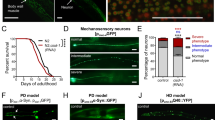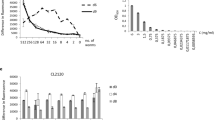Abstract
Genetic studies indicate that protein homeostasis is a major contributor to metazoan longevity1. Collapse of protein homeostasis results in protein misfolding cascades and the accumulation of insoluble protein fibrils and aggregates, such as amyloids2. A group of small molecules, traditionally used in histopathology to stain amyloid in tissues, bind protein fibrils and slow aggregation in vitro and in cell culture3,4. We proposed that treating animals with such compounds would promote protein homeostasis in vivo and increase longevity. Here we show that exposure of adult Caenorhabditis elegans to the amyloid-binding dye Thioflavin T (ThT) resulted in a profoundly extended lifespan and slowed ageing. ThT also suppressed pathological features of mutant metastable proteins and human β-amyloid-associated toxicity. These beneficial effects of ThT depend on the protein homeostasis network regulator heat shock factor 1 (HSF-1), the stress resistance and longevity transcription factor SKN-1, molecular chaperones, autophagy and proteosomal functions. Our results demonstrate that pharmacological maintenance of the protein homeostatic network has a profound impact on ageing rates, prompting the development of novel therapeutic interventions against ageing and age-related diseases.
This is a preview of subscription content, access via your institution
Access options
Subscribe to this journal
Receive 51 print issues and online access
$199.00 per year
only $3.90 per issue
Buy this article
- Purchase on Springer Link
- Instant access to full article PDF
Prices may be subject to local taxes which are calculated during checkout




Similar content being viewed by others
Change history
14 April 2011
In Fig. 4, units were corrected to μM.
References
Morimoto, R. I. Proteotoxic stress and inducible chaperone networks in neurodegenerative disease and aging. Genes Dev. 22, 1427–1438 (2008)
Balch, W. E., Morimoto, R. I., Dillin, A. & Kelly, J. W. Adapting proteostasis for disease intervention. Science 319, 916–919 (2008)
Porat, Y., Abramowitz, A. & Gazit, E. Inhibition of amyloid fibril formation by polyphenols: structural similarity and aromatic interactions as a common inhibition mechanism. Chem. Biol. Drug Des. 67, 27–37 (2006)
Frid, P., Anisimov, S. V. & Popovic, N. Congo red and protein aggregation in neurodegenerative diseases. Brain Res. Brain Res. Rev. 53, 135–160 (2007)
Kenyon, C. The plasticity of aging: insights from long-lived mutants. Cell 120, 449–460 (2005)
Tullet, J. M. et al. Direct inhibition of the longevity-promoting factor SKN-1 by insulin-like signaling in C. elegans . Cell 132, 1025–1038 (2008)
Morley, J. F. & Morimoto, R. I. Regulation of longevity in Caenorhabditis elegans by heat shock factor and molecular chaperones. Mol. Biol. Cell 15, 657–664 (2004)
Hsu, A. L., Murphy, C. T. & Kenyon, C. Regulation of aging and age-related disease by DAF-16 and heat-shock factor. Science 300, 1142–1145 (2003)
Cohen, E., Bieschke, J., Perciavalle, R. M., Kelly, J. W. & Dillin, A. Opposing activities protect against age-onset proteotoxicity. Science 313, 1604–1610 (2006)
Groenning, M. Binding mode of Thioflavin T and other molecular probes in the context of amyloid fibrils—current status. J. Chem. Biol. 3, 1–18 (2009)
Rodríguez-Rodríguez, C. et al. Design, selection, and characterization of thioflavin-based intercalation compounds with metal chelating properties for application in Alzheimer’s disease. J. Am. Chem. Soc. 131, 1436–1451 (2009)
Drake, J., Link, C. D. & Butterfield, D. A. Oxidative stress precedes fibrillar deposition of Alzheimer’s disease amyloid β-peptide (1–42) in a transgenic Caenorhabditis elegans model. Neurobiol. Aging 24, 415–420 (2003)
McColl, G. et al. The Caenorhabditis elegans Aβ1–42 model of Alzheimer’s disease predominantly expresses Aβ3–42 . J. Biol. Chem. 284, 22697–22702 (2009)
Temussi, P. A., Masino, L. & Pastore, A. From Alzheimer to Huntington: why is a structural understanding so difficult? EMBO J. 22, 355–361 (2003)
Gidalevitz, T., Ben-Zvi, A., Ho, K. H., Brignull, H. R. & Morimoto, R. I. Progressive disruption of cellular protein folding in models of polyglutamine diseases. Science 311, 1471–1474 (2006)
Zengel, J. M. & Epstein, H. F. Identification of genetic elements associated with muscle structure in the nematode Caenorhabditis elegans . Cell Motil. 1, 73–97 (1980)
Anderson, P. & Brenner, S. A selection for myosin heavy chain mutants in the nematode Caenorhabditis elegans . Proc. Natl Acad. Sci. USA 81, 4470–4474 (1984)
Ben-Zvi, A., Miller, E. A. & Morimoto, R. I. Collapse of proteostasis represents an early molecular event in Caenorhabditis elegans aging. Proc. Natl Acad. Sci. USA 106, 14914–14919 (2009)
Lakowski, B. & Hekimi, S. The genetics of caloric restriction in Caenorhabditis elegans . Proc. Natl Acad. Sci. USA 95, 13091–13096 (1998)
Chen, D., Thomas, E. L. & Kapahi, P. HIF-1 modulates dietary restriction-mediated lifespan extension via IRE-1 in Caenorhabditis elegans . PLoS Genet. 5, e1000486 (2009)
Murphy, C. T. et al. Genes that act downstream of DAF-16 to influence the lifespan of Caenorhabditis elegans . Nature 424, 277–283 (2003)
Walker, G. A. & Lithgow, G. J. Lifespan extension in C. elegans by a molecular chaperone dependent upon insulin-like signals. Aging Cell 2, 131–139 (2003)
Li, W., Gao, B., Lee, S. M., Bennett, K. & Fang, D. RLE-1, an E3 ubiquitin ligase, regulates C. elegans aging by catalyzing DAF-16 polyubiquitination. Dev. Cell 12, 235–246 (2007)
McColl, G. et al. Pharmacogenetic analysis of lithium-induced delayed aging in Caenorhabditis elegans . J. Biol. Chem. 283, 350–357 (2008)
Chen, D., Thomas, E. L. & Kapahi, P. HIF-1 modulates dietary restriction-mediated lifespan extension via IRE-1 in Caenorhabditis elegans . PLoS Genet. 5, e1000486 (2009)
Timmons, L., Court, D. L. & Fire, A. Ingestion of bacterially expressed dsRNAs can produce specific and potent genetic interference in Caenorhabditis elegans . Gene 263, 103–112 (2001)
McColl, G. et al. Insulin-like signaling determines survival during stress via posttranscriptional mechanisms in C. elegans . Cell Metab. 12, 260–272 (2010)
Acknowledgements
We thank A. A. Gerencser for expert assistance with the confocal microscopy; A. M. Cuervo, M. S. Gill, M. Lucanic, J. Campisi, S. Melov, V. Lunyak and P. Kapahi for suggestions on the manuscript, members of the G.J.L. and P. Kapahi laboratories for helpful discussion and members of the Paper Polishing Club. Nematode strains were provided by the Ceanorhabditis Genetics Center, funded by the National Institutes of Health (NIH) National Center for Research Resources. CF2189 was a gift from C. Kenyon’s laboratory. This work was supported by grants from the Larry L. Hillblom Foundation and the NIH (UL1024917, supporting the Interdisciplinary Research Consortium on Geroscience and 1R01AG029631-01A1). G.J.L. is supported by the NIH AG21069, AG22868, AG029631-01A1, ES016655, the Larry L. Hillblom Foundation and UL1 RR024917. S.A. was supported by the U19AGO231222 from the Longevity Consortium.
Author information
Authors and Affiliations
Contributions
S.A. planned and designed the project with consultation and support from G.J.L. All the data were collected by S.A. and M.C.V., with assistance from D.J.S.Z. and I.M.K. S.A. and G.J.L. wrote the paper with contribution from all authors.
Corresponding authors
Ethics declarations
Competing interests
The authors declare no competing financial interests.
Supplementary information
Supplementary Information
The file contains Supplementary Figures 1-16 with legends and Supplementary Table 1. (PDF 1163 kb)
Rights and permissions
About this article
Cite this article
Alavez, S., Vantipalli, M., Zucker, D. et al. Amyloid-binding compounds maintain protein homeostasis during ageing and extend lifespan. Nature 472, 226–229 (2011). https://doi.org/10.1038/nature09873
Received:
Accepted:
Published:
Issue Date:
DOI: https://doi.org/10.1038/nature09873
This article is cited by
-
Spliceosome component Usp39 contributes to hepatic lipid homeostasis through the regulation of autophagy
Nature Communications (2023)
-
Unraveling effects of anti-aging drugs on C. elegans using liposomes
GeroScience (2023)
-
Multidimensional insights into the repeated electromagnetic field stimulation and biosystems interaction in aging and age-related diseases
Journal of Biomedical Science (2022)
-
Exogenous misfolded protein oligomers can cross the intestinal barrier and cause a disease phenotype in C. elegans
Scientific Reports (2021)
-
Two human metabolites rescue a C. elegans model of Alzheimer’s disease via a cytosolic unfolded protein response
Communications Biology (2021)
Comments
By submitting a comment you agree to abide by our Terms and Community Guidelines. If you find something abusive or that does not comply with our terms or guidelines please flag it as inappropriate.



